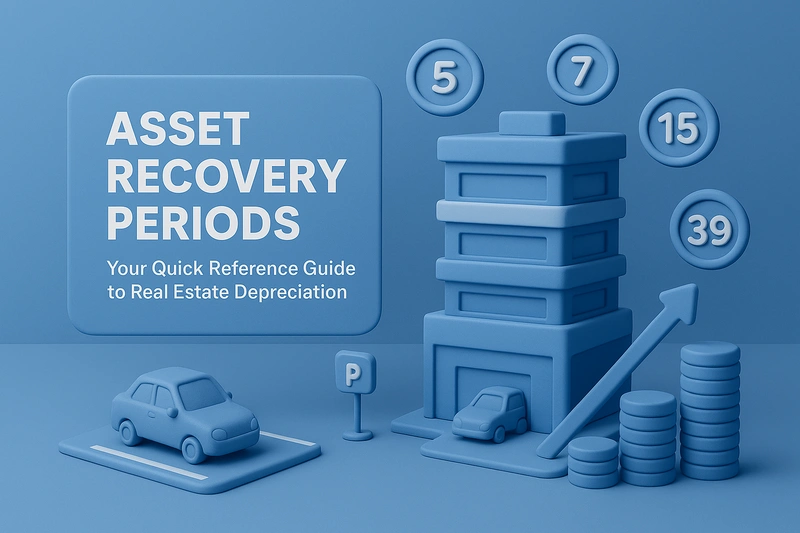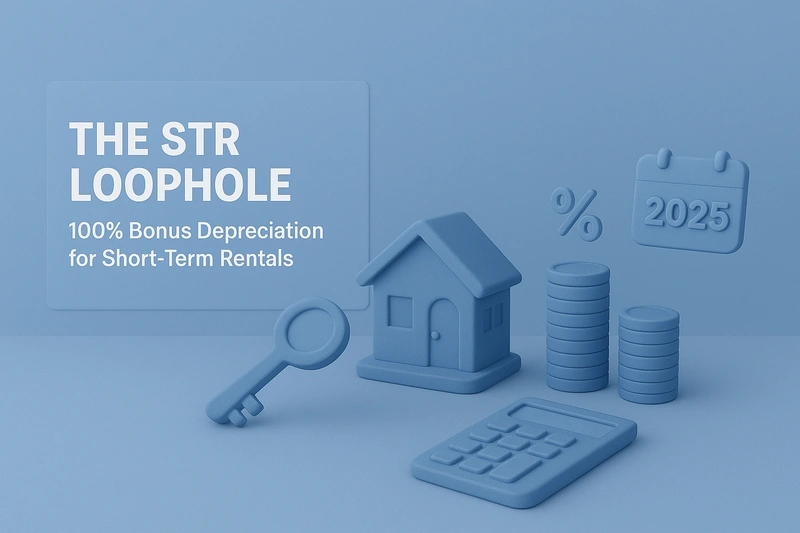Understanding asset recovery periods can save real estate investors thousands in annual tax deductions through strategic cost segregation. With the Big Beautiful Bill now in effect, providing permanent 100% bonus depreciation for properties placed in service after January 19, 2025, proper asset classification has become more critical than ever.
The difference between classifying an asset as 5-year property versus 39-year property directly impacts your cash flow. A $100,000 parking lot improvement generates $5,000 in first-year depreciation as 15-year property (using 150% declining balance) compared to just $2,564 if incorrectly classified as 39-year property. With 100% bonus depreciation, that same parking lot generates an immediate $100,000 deduction when properly classified.
This guide simplifies complex IRS recovery periods into actionable categories real estate investors use daily. For investors working with R.E. Cost Seg, this serves as a companion resource to understand how professional cost segregation services identify and reclassify assets to accelerate depreciation.
Quick Reference: Common Recovery Periods
Note: These classifications assume General Depreciation System (GDS) treatment. 100% bonus depreciation applies to assets with recovery periods of 20 years or less for properties placed in service after January 19, 2025.
5-Year Property: Technology, Equipment & Fixtures
Five-year property represents the shortest standard recovery period and encompasses a broader range than many investors realize. This category generates the most immediate tax benefits, especially with 100% bonus depreciation now permanent.
Technology & Equipment:
- Computers, servers, telecommunications systems
- Point-of-sale systems and cash registers
- Security systems beyond basic building requirements
- Kitchen equipment (ovens, fryers, refrigeration units)
- Medical equipment and specialized systems
- Appliances in rental properties (when removable)
Fixtures & Decorative Elements:
- Decorative millwork (crown molding, chair rails)
- Window treatments (blinds, curtains)
- Movable partitions not extending floor to ceiling
- Display cases and specialized shelving
- Decorative lighting fixtures
- All hotel furniture and furnishings
Key Test: Does the asset serve specific equipment/operations rather than the building generally? Is it removable without structural damage?
7-Year Property: Office Furniture
Seven-year property is surprisingly limited, consisting primarily of:
- Traditional office furniture (desks, chairs, conference tables)
- Filing cabinets and storage systems
- Modular workstation systems
This narrow category specifically excludes decorative fixtures, partitions, and specialty items that qualify for more favorable 5-year treatment.
15-Year Property: Land Improvements
Fifteen-year property includes all improvements to the land that aren't part of the building structure. These assets use 150% declining balance depreciation, providing accelerated deductions even without bonus depreciation.
Site Infrastructure:
- Parking lots, driveways, and loading areas
- Sidewalks and walkways
- Retaining walls and drainage systems
- Site utilities (when not serving the building)
Landscaping & Amenities:
- Trees, shrubs, sod, and plantings
- Irrigation systems
- Fencing and gates
- Security bollards and barriers
Signage & Lighting:
- Freestanding signs and monuments
- Parking lot lighting
- Perimeter security lighting
Qualified Improvement Property (15-Year)
QIP includes interior improvements to nonresidential buildings placed in service after the building's initial service date:
- Interior build-outs
- Non-structural walls and partitions
- Ceiling and flooring systems
- HVAC modifications for specific spaces
Excludes: Building enlargements, elevators, escalators, and structural framework
27.5-Year Residential Rental Property
Residential rental property qualifies for 27.5-year straight-line depreciation when at least 80% of gross rental income comes from dwelling units:
- Apartment complexes
- Single-family rentals
- Student housing (non-transient)
- Senior living facilities (non-medical)
The 80% test excludes income from services, separately charged parking, and laundry facilities. Properties failing this test depreciate over 39 years.
39-Year Nonresidential Real Property
Commercial buildings and their structural components depreciate over 39 years:
- Office buildings and retail centers
- Hotels and hospitality properties
- Warehouses and industrial facilities
- Building shell and structural systems
- Central HVAC, plumbing, and electrical serving the building
Key Distinction: Systems serving the building generally (39-year) versus systems serving specific equipment or limited areas (5-year).
Practical Application Examples
Medical Office Building:
- Building structure: 39 years
- Central HVAC: 39 years
- Medical equipment: 5 years
- Oxygen/gas outlets for equipment: 5 years
- Office furniture: 7 years
- Parking lot: 15 years
Hotel Property:
- Building structure: 39 years
- Guest room furniture: 5 years
- Lobby furnishings: 5 years
- Decorative fixtures: 5 years
- Landscaping: 15 years
Retail Center:
- Building shell: 39 years
- Display fixtures: 5 years
- Checkout counters: 5 years
- Parking lot and sidewalks: 15 years
- Monument signage: 15 years
Common Classification Errors to Avoid
- Classifying all furniture as 7-year property - Hotel furniture, decorative fixtures, and movable partitions are 5-year property
- Missing 15-year land improvements - Parking lots, landscaping, and site lighting often get incorrectly included with the building
- Overlooking specialized systems - Equipment-specific electrical, plumbing, and HVAC qualify for 5-year treatment
- Defaulting everything to 39 years - Without segregation, you miss 20-30% of assets that qualify for shorter lives
Key Takeaways
With permanent 100% bonus depreciation for properties placed in service after January 19, 2025, proper asset classification has never been more valuable. A typical commercial property contains:
- 5-10% in 5-year property
- 1-3% in 7-year property
- 10-20% in 15-year property
- 10-15% in land value (non-depreciable)
- 55-75% in 27.5 or 39-year property
Professional cost segregation studies document these classifications with engineering-based analysis, maximizing your depreciation benefits while ensuring IRS compliance. For properties over $500,000, the first-year tax savings typically exceed the study cost 10 times over.






